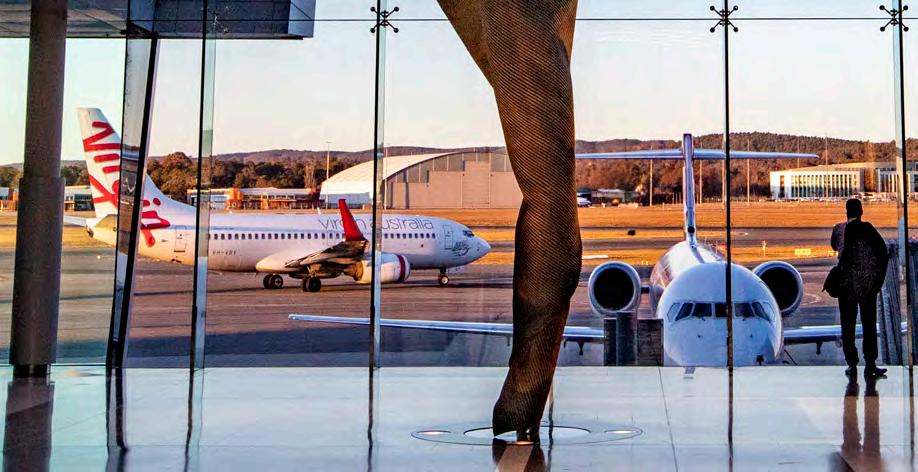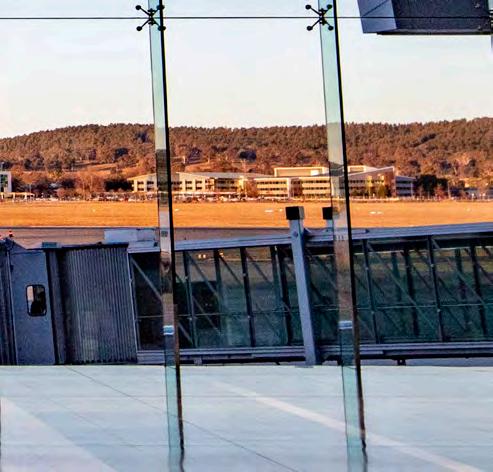
9 minute read
Under the radar
How is Australia’s capital city gateway, Canberra Airport, faring in what is turning out to be the toughest ever year for aviation? Joe Bates investigates.
It is probably fair to say that Australia’s capital city gateway, Canberra Airport, goes under the radar compared to some of the country’s bigger and better-known airports.
Advertisement
Indeed, the 3.3 million travellers that passed through its facilities last year meant that Canberra (CBR) was Australia’s eighth busiest airport for passenger traffic, handling a fraction of the 27.5 million and 26 million passengers handled at Sydney (SYD) and Melbourne (MEL) respectively.
However, don’t confuse its size with a lack of ambition, because with the notable exception of 2020, traffic has been on an upwards trajectory in Canberra since 2015, and the trend has led to CBR opening new capacity enhancing infrastructure this year to ensure that it is better equipped to meet long-term demand.
AIRFIELD SAFETY
On August 13, Canberra Airport celebrated the opening of its new Taxiway Bravo, which the airport’s head of aviation, Michael Thomson, notes completed a 14-month project to improve aircraft safety and reduce passenger travel times.
“Taxiway Bravo aligns with our long-term vision as a world-class, small international airport to be as safe and efficient as possible and provide the best travel-experience we can help to facilitate, now and well into the future,” enthuses Thomson.
CBR operator, Capital Airport Group, worked closely with Huon (the main contractor) and Spiire (superintendent on the project) to ensure that the new taxiway was delivered on time and on budget.
Canberra Airport’s head of projects, Zarko Danilov, says: “Around 150 people have worked tirelessly on this build to create a 1.6 kilometre taxiway that will enable large international aircraft – and domestic planes – to move more safely around the airfield.
“It may just look like a large road to many, however, to build such a road capable of carrying planes in excess of 180 tonnes takes some serious engineering and a lot of hard work.
“Taxiway Bravo eliminates the need for planes to cross the main runway (which is the current arrangement) and clears the path for more planes landing or taking off. In short, it makes the whole airfield safer and more efficient.”
NEW SECURITY SCREENING SYSTEM
Another 2020 success worth noting is the installation of a new security screening system with technology from Rapiscan Systems (body scanners) and Smiths Detection (security machines) to further improve the screening of passengers and their carry-on luggage.
Thomson says: “We have invested in the new technology as part of our ongoing improvements to enhance the passenger experience – without compromising on safety – and to meet new government regulations regarding security screening at airports.
“They also allow for better utilisation of staff while increasing the security outcome for everyone. Whether it be for business or leisure, get back to flying through our COVID-safe Canberra Airport knowing that it is now even easier and even safer to reach your destination.”
IMPACT OF COVID-19 ON TRAFFIC
There is simply no denying that passenger numbers at CBR, like at most of the world’s airports, have suffered hugely as a result of COVID-19, and with travel bans in operation at six of Australia’s eight states and territories at the time of going to press, the next few months will be a struggle.
The impact of COVID-19 on Canberra Airport was almost instant, with passenger traffic dropping 98% in March/April as airlines scaled back services or ceased flying all together.
Indeed, the airport went from handling 770 flights per week to double digits, and the lack of scheduled flights forced CBR to close its passenger terminal on April 15th and 16th.
Things picked up in June with the return of a number of services to Sydney and Melbourne followed by Adelaide, Brisbane, Newcastle and Ballina/Byron Bay, but the closure of neighbouring Victoria’s borders in July and Queensland’s in August has once again hit passenger numbers.
The situation led to the recent Saturday closures of the entire airport (August 22 and 29) and Thomson admits that more Saturday, and possibly Tuesday closures may lie ahead as Canberra Airport adjusts to the new normal of today’s COVID-19 impacted world.
He is, however, in no doubt that traffic will return in the future and is quick to point out that CBR is doing all that it can to stay open and to keep people employed as it works hard to “reinvigorate domestic aviation travel”.
“We are committed to the recovery of Australian domestic aviation and the importance it has for thousands of people’s livelihood and the economy,” insists Thomson.
“Yet without a domestic aviation recovery plan in place there will be no Australian aviation and thousands more jobs will be lost. We need a national domestic aviation recovery plan."
NATIONAL EFFORT REQUIRED TO OVERCOME PANDEMIC
Thomson is calling on all governments within Australia to develop a national aviation recovery plan – a plan that adheres to health authority advice and one that allows people to travel based on a risk assessment and passengers meeting prerequisites for travel.
He explains: “A national plan developed by the Federal Government and the Australian states and territories is therefore essential for the recovery of aviation and the thousands of jobs that rely on it.

“A plan that enables the recovery of aviation will not only stimulate the economy through jobs directly in the aviation and tourism sectors but also all of the associated industries including hire cars, accommodation, retail, education and hospitality.
“The plan should focus on establishing the environment required to re-start flights and the management of the risks of COVID-19 in accordance with health authority advice.
“It should require travellers and all in the industry to meet prerequisites for travel and work.”
Thomson has little hesitation in admitting that the pandemic has ensured a very hard year for Canberra Airport, all airport staff and for most businesses associated with the gateway.
Like other airports, reducing its costs is now a top priority and Thomson notes that his staff have agreed to salary reductions, increased leave periods and in some cases accept redundancy packages to ensure that CBR is best positioned to survive the pandemic.
Other cost cutting measures have included closing half of the domestic terminal and all of the international terminal and ceasing all unnecessary expenditure.
Efforts to make CBR a safe environment for staff and passengers include becoming the first major airport in Australia to use thermal cameras for body temperature screening (EOS Australia); increasing the cleaning of high touchpoint areas across the terminal; providing touchless entry to the airport from the car park; and the now standard introduction of physical distancing measures and installation of hand sanitiser stations.
TRAFFIC TRENDS
The current global downturn in traffic makes it almost impossible to predict what the next couple of years will bring for CBR in terms of passenger numbers and route development.
Prior to COVID-19, annual throughput at CBR was expected to almost treble to 9mppa over the next 20 years, meaning that the gateway wouldn’t need any major new infrastructure until the 2030s at the earliest.
As a result, the airport’s master plan outlines plans to extend both the southern and western ends of the existing terminal in the 2030s to raise CBR’s capacity to 12mppa.
For now, there is obviously no need to revise these plans as no decisions have to be made for at least a decade and it may be at least two years before traffic at CBR returns to 2019 levels.
CBR is primarily a domestic O&D airport for Canberra, the neighbouring city of Queanbeyan and the surrounding region that includes the Australian Capital Territory (ACT) and much of south eastern New South Wales.
In 2019, CBR was served by six airlines between them operating non-stop services to six domestic and two international destinations – Doha and Singapore.
“We play a significant role in the Australian airport system as the gateway to the nation’s capital facilitating travel for business, tourism, defence and political engagement in the capital,” says Thomson,
“We also provide a retail hub for passengers and their around two million ‘meeters and greeters’ each year.
“Over the years Canberra Airport has developed and changed considerably. When the Snow family purchased the aerodrome in 1998, Canberra Airport was an airport which did not befit its status as a gateway to the National Capital of Australia and was in need of a significant infrastructure upgrade.
“Today, we have world-class terminal facilities and can accommodate all types of aircraft other than A380s. We began as a small domestic airport and now we are an international hub with Qatar Airways and Singapore Airlines opening Canberra to the world.”
Longer-term, CBR harbours ambitions to handle services to Bangkok, Dubai, Mainland China, Hong Kong, Hawaii, Los Angeles, Tokyo and New Zealand.
Traditionally the top three airlines at CBR are Qantas (including QantasLink), Virgin Australia and FlyPelican with Melbourne-Canberra being the most popular route by some way, followed by the Sydney, Brisbane, Adelaide and Gold Coast in terms of market share.

POSITIVE MENTAL ATTITUDE
In times of such negativity, can Thomson give us three reasons why he is confident that the aviation industry, and CBR, will recover from COVID-19 and see passenger numbers once again equal and eventually surpass 2019’s levels?
“Aviation will recover, it is just a question of when,” states Thomson, listing the industry’s historical resilience to adversity, its importance to the global economy, and peoples’ desire to travel as his three reasons.
“The world has seen global pandemics and other disruptions to aviation before and aviation travel always returns,” explains Thomson.
“This is especially relevant for a country such as Australia where the vast distances between cities and the rest of the world make air travel necessary.
“Make no mistake about it, aviation is critical to the world’s ability to function on many levels. People and practices will adapt, and we will find ways to live with COVID-19. We will see aviation return as the COVID-19 related risks associated with travel are managed appropriately as opposed to blanket closures of borders.
“Not everything can be achieved in business, and certainly not in tourism, via a video link. Face-to-face meetings and direct human engagement for families and friends is essential because we are human.
“Finally, there is still demand. People want to travel. They just need to know that they can travel in a COVID-19 safe way – and that depends on authorities taking action and showing strong leadership to allow a risk managed approach to the problem and not blanket closures of borders.”
While Australia considers the merits of a national aviation recovery plan to help it emerge from COVID-19, you can be assured that Canberra Airport will continue to do all it can to ensure that it is a safe and friendly place to use whatever the purpose of your visit.







